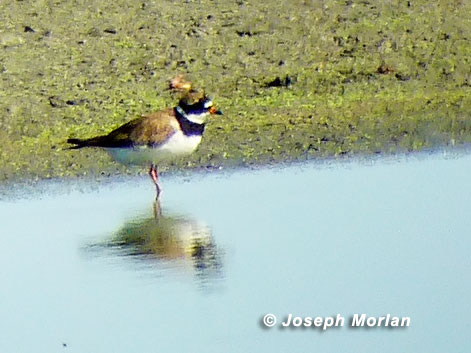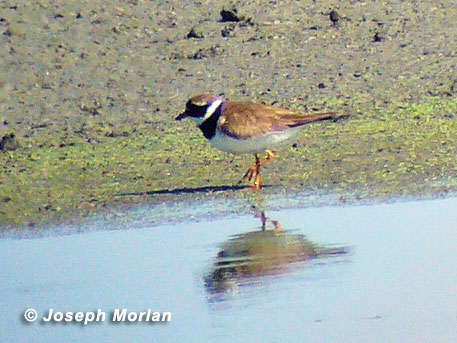Davis Wetlands, Davis, Yolo County, CA
24 August 2011
Joseph Morlan
Photos © 24 August 2011 by Joseph Morlan. All rights reserved.

Common Ringed Plover (Charadrius hiaticula)
Davis Wetlands, Davis, Yolo County, CA
24 August 2011
Joseph Morlan
Photos © 24 August 2011 by Joseph Morlan. All rights reserved. 
Dan Singer, Robbie Fischer and I decided to stop at the Davis
Wetlands on our way home from the Western Field Ornithologists conference in Sierra Vista, Arizona to try for
the Common Ringed Plover which had been found by Todd Easterla on 19 August. During our drive up from Buttonwillow
where we spent the night, we learned from an Internet posting that the bird was still present. We checked in at
the gate and followed the auto tour loop around to the southwest corner of the public ponds where we noticed a
group of birders with scopes all pointing in the same direction. The bird was still present on a mud strip a moderate
distance away but in go od light. Direct comparison with 2-3 Semipalmated Sandpipers was available. I attempted
to digiscope this bird, but the distance was too great to obtain as much detail as I would have liked. Three images
are posted here, and slightly larger versions are here.
od light. Direct comparison with 2-3 Semipalmated Sandpipers was available. I attempted
to digiscope this bird, but the distance was too great to obtain as much detail as I would have liked. Three images
are posted here, and slightly larger versions are here.
Description
The following description is based on memory and on photos:
A small plover, similar to Semipalmated Plover, but clearly larger in direct comparison and decidedly larger than nearby Least Sandpipers. This individual was fairly easy to spot because it was still in full breeding plumage while the Semipalmated Plovers were in basic plumage with all dark bills. Two of the Semipalmated Plovers had brown chest bands, but one, presumably an adult male, had a black chest band which was narrower than that of the Common Ringed Plover. The face pattern of the Common Ringed Plover differed in having much more black around the nape contrasting with the white neck ring. Above a black border extended into a broad mask that included the eye. No orange eyering was evident as usually seen on Semipalmated Plover. The black continued narrowly below the white forehead across the top of the bill. The black lores appeared to meet t
he gape of the bill. Another dark bar connected both eyes across the top of the white forehead. The rest of the upperparts, including the crown were solid brown except for a small white stripe above and behind the eye. The underparts were snow white except for the broad black chest band. The bill had a bright orange base and black tip and appeared to be slightly larger than that of the Semipalmated Plovers. The legs appeared orange in the field, but look pinkish in some of my photos. The wings were long and pointed, almost reaching the tip of the tail. When stretching, a white wing stripe was seen briefly but I was unable to characterize it in more detail. No vocalizations were heard during the hour we studied the bird.
Discussion
There are three prior records of this species for California, but none have been accepted by the California
Bird Records Committee. An individual well seen at Point Reyes 9 September 1996 was heard to give typical Common
Ringed Plo ver call-notes, but no recordings or photos were obtained. I believe that sight-record
to be almost certainly correct and would recommend that it be reviewed again assuming the Davis bird is found to
be acceptable. The 1996 record would have been a first for the state but the committee usually prefers more tangible
evidence before adding new species to the California state list. The Davis individual has been fairly cooperative
and there are numerous diagnostic photos. Voice recordings were obtained when a
local TV station covered the story. I made a short mp3 audio clip from the video which you can listen to here. Sonogram from the audio is to the right.
ver call-notes, but no recordings or photos were obtained. I believe that sight-record
to be almost certainly correct and would recommend that it be reviewed again assuming the Davis bird is found to
be acceptable. The 1996 record would have been a first for the state but the committee usually prefers more tangible
evidence before adding new species to the California state list. The Davis individual has been fairly cooperative
and there are numerous diagnostic photos. Voice recordings were obtained when a
local TV station covered the story. I made a short mp3 audio clip from the video which you can listen to here. Sonogram from the audio is to the right.
Two subspecies are currently recognized. Nominate C. h. hiaticula which breeds in NE Canada and Greenland to Scandinavia tends to have more white on the supercilium and a somewhat heavier bill than C. h. tundrae which breeds in Russia and Siberia occurring regularly to Western Alaska where it breeds on St. Lawrence Island. However variation is slight and somewhat clinal. In C. h. hiaticula, adult males have limited pre-alternate molt and appear to be in breeding plumage throughout the year according to Chandler (2009). Molt in tundrae is possibly more extensive, but the situation is unclear. Pyle (2008) considers the species to be monotypic.
Additional Photos and Video (external links)
Todd
Easterla - 20 August (Yahoo ID and CVBirds membership required)
Steve Hampton - 20 August
Sonny Mencher - 20 August
Linda Pittman - 21 August
Mark J. Rauzon - 22 August
(additional photos)
CBS13
Sacramento - 23 August (Video with voice recordings and interview with Todd Easterla).
John
Sterling - 23 August
Douglas Herr - 23 August
Craig Swolgaard - 24 August
Dan Brown - 26 August
Tom Benson - 26 August
Sacramento Bee - 27
August (Video, stills, narrated by Joan Humphrey)
Updates
The bird was present through the morning of 26 August. That evening it had moved to the Yolo Bypass (Vic Fazio)
Wildlife Area in Davis where it was seen flying off to the South. It was not seen the next day.
References
Chandler, R. 2009. Shorebirds of North America, Europe and Asia. Princeton Univ. Press.
Dunn, J. L. 1993. The identification of Semipalmated and Common Ringed Plovers in alternate plumage. Birding.
25:238-243. [PDF]
Lakin, I., and Rylands, K. 1997. The Semipalmated Plover in Devon: The second British record. Birding World
10:212-216.
Lehman, P. 2006. Autumn plumages from the Bearing Sea region. Alaska. Birding 38(5) :26-33. [PDF]
Pyle, P. 2008. Identification Guide to North American Birds, Part II Anatidae to Alcidae. Slate Creek Press.